Ships directly from the publisher.
Concepts in Level 1
Grand Staff
Grand Staff, clefs, key signatures (C,F,G), time signatures, double bar lines, measure, staff, repeat sign, brace, bar lines. Draw clefs, braces, bar lines, and repeat signs.
Note Names
Notes on keyboard and staff from bass G to treble F. Sharps, flats, naturals. Draw line from staff to keyboard.
Intervals
Identify harmonic and melodic intervals from prime to 5th.
Scales
Identify whole and half steps on the keyboard and staff. Identify major and minor 5-finger patterns and formulas using whole and half steps. Identify tonic and dominant notes.
Chords
Name triads on staff by the root note and Roman numerals.
Chord Progressions
Identify primary chord progressions, plagal, and authentic cadences using Roman numerals.
Meter and Rhythm
Name and draw quarter, eighth, half, dotted half, and whole notes. Name and draw quarter, half, dotted half, and whole rests. Identify time signatures and ties. Add bar lines and missing notes.
Symbols and Terms
Flat, sharp, natural, 8va, fermata, ritardando, piano, forte, a tempo, loco, harmony, melody, legato, staccato
Analysis
Beats, measures, dynamics, intervals, articulation, time signatures, note values, starting note, ties, slurs, patterns, 5-note scales, triad, AA and AB form, symbols, terms, key signatures for C, F, G. Draw clefs, brace, repeat signs.
Music History
Keyboard instruments, staff, composer, keyboard geography, folk music, the invention of piano.
Concepts in Level 2
Staff
Write the order of Sharps & Flats
Note Names
Enharmonic notes to match the keyboard
Intervals
Identify Harmonic and Melodic Intervals 1-8
Scales
5 note scales on Keyboard
Chords
Triads Major/minor on keyboard
Chord Progression
Plagal Cadence IV I Roman Numerals
Rhythm
2/4, 3/4, 4/4 write in counting, determine time signature, musical math
Symbols & Terms
Tie, Slur, Andante, Allegro, Moderato, Crescendo, Diminuendo, Fine, Phrase, Natural, mf, f, mp, p
Analysis
Tie/Slur, mp/mf, Tempo, Fermata, Legato
Music History
Cristofori, pianoforte, voice, church & home
Concepts in Level 3
Staff
Draw order of Sharps & Flats
Note Names
Name the notes above & below the staff – ledger line
Intervals
Draw intervals 1-8
Scales
Know the WS/HS pattern on Major scale. Draw the 8 note scales on the keyboard.
Chords
Identify Major & minor triads on staff. Draw inversions on keyboard.
Chord Progression
Identify I IV V7 in the score
Rhythm
2/4, 3/4 Identify eighth notes, quarter note, quarter rest, half note, half rest, whole note, whole rest, dotted quarter notes
Symbols & Terms
Accent, accidental, allegro, andante, DC al fine, Da Capo, Diminuendo, Dolce, Harmony, Melody, ff, f, mf, mp, p, pp
Analysis
cresc/dim, moderato, form AA AB, rests/notes
Music History
4 musical periods, organ, harpsichord, clavichord, Ionian=Major, Aeolian=minor, WSHS patterns
Concepts in Level 4
Grand Staff
Write sharps and flats in order (5 pages each)
Symbols,Terms
DS al fine,coda,tranquillo,vivace,tenuto,lento,accel,x,bb,rall,trill,sempre
Intervals
Includes harmonic & melodic – circle the Perfect
Chords
M, m, Aug, Dim – name the quality
Scales
M, m, harmonic minor – add the accidentals
Cadences
Write the cadence – M & m (I,IV,I,V7,I)
Note Names
Includes ledger line notes – inside and outside staff
Note Values
Write in the counting ¾, 6/8, 4/4, 3/8, C, 6/4, 9/8, 2/2, 5/4 (9)
Write number of counts 4/4, 6/8, C, ¾ (5)
What is the value of the “dot” (8)
Draw the bar lines 4/4, 6/8, ¾, C, 9/8 (8)
Key Signatures
Draw the #s and bs in order
Draw the # and b key signatures
Name the # and b key signatures
Name the Major then Relative Minor
Concepts in Level 5
Symbols, Terms:
Questions and Answers (word)
(On staff covered in Analysis)
Staff: Find relative minor & Recognize Major & minor key signatures
write Major and minor key signatures,
Scales
Circle of 5ths – Major (word)
Recognize & write 3 forms of minor scales
Write the scales
Note Names
Chords
Roman Numerals I, i, III+, vii°
Primary Chords with Roman Numerals
Name the chord (includes Major, minor, Aug, dim)
Recognize and write the Quality of Triads in Major and Harmonic Scales
Intervals
Recognize Major , Minor & Perfect 2nd through 8th
Write Major and Minor intervals above & below given note
Note Values
Includes Write number of counts ,
Write in the counting & Meter 2Cadences
Write complete authentic cadences in Major and minor
Analysis
Recognize and write Antecedent and Consequent
Recognize Complete Authentic Cadence (Major and minor)
Concepts in Level 6
Staff
Recognize Major & minor key signatures
Write Major & minor key signatures
Intervals
Recognize & write Harmonic intervals (include diminished and augmented)
Scales
Know Primary Chords (Major & minor with Roman numerals)
Write and name scale degrees of triads
Notes & Rests
Write in counting, add one note or rest to complete the measure
Recognize Time Signatures, Meter, Conducting Patterns
Note Names
Recognize and spell triads (Major, minor, dim, Aug)
Cadences
Write chord progressions in major and minor (tonic in Root position)
Chords
Recognize & write triads in inversions (M,m,d,A)
Recognize Figured Bass, Write Figured Bass
Terms, Symbols:
Simile, marcato, non troppo, anacrusis, grave, senza, pedal, sfortzando, mordent, alla breve
Analysis
Recognize Imitation, Minuet and Trio, ABA or Ternary Form
Review Form and previously covered information
Circle of 5ths with relative minor
Name the order of #’s and b’s
Concepts in Level 7
Staff
Transpose notated melody to new key
Intervals
Recognize and write number and quality of intervals
Write intervals
Scales
Recognize and write a Chromatic Scale – ascending and descending
Recognize and write Triads w/symbols and degree names in a harmonic minor scale
Roman numerals
Scale Degree names
Note Value and Rhythm
Recognize and write Simple, Compound and Asymmetrical Meter
Recognize and write notation and counting
Note Names
Recognize and write Major and Harmonic Minor Scales – Parallel Keys
Chord Progression
Recognize and write harmony by adding the chord root on the bass staff, write Roman numerals
Chords
Recognize and write Dominant 7th Chords with accidentals & inversions w/figured bass
Instructions to Recognize and write Figured Bass for Dominant 7th Chords
Review – name triad’s inversions with figured bass
Analysis
Recognize Imitation, Sequencing, Repetition and Recapitulation
Review form
Key Signatures Major & minor
Concepts in Level 8
Staff
Transpose on staff.
Harmonize melody.
Intervals
Invert intervals and identify quality of new interval
Scales
Draw a complete circle of 5ths with M/m & Key Signature
Write a whole tone scale on staff
Note Value and Rhythm
Write Augmentation and Diminution of given notation.
Note Names
Spell scales of enharmonic keys
Chord Progression
Write on staff Cadence I IV V7 I with inversions
Write on staff Figured Bass
Symbols & Terms
piu, assai meno, non, con, ma, allargando, semplice, senza, spiritoso, brillante, sostenuto
Review previous terms
Chords
Write on staff MM, Mm, mm, dm, dd
Analysis
Sonata form – exposition, development, recapitulation
History
Pre-Baroque, “tempering” Bach “The Well Tempered Claier”, scales, chords, intervals
M,m,dim, aug, Concerto, Character piece
Melodic and Harmonic repetition
Rhythmic repetition
Key Signatures Major & minor
Circle of 5ths
Concepts in Level 9
Staff
Draw a grand staff, all parts, write music
Intervals
Recognize and write number and quality of intervals
Write intervals
Scales
Recognize and write M, m (3), Modes, Jazz, Whole Tone, Chromatic Scale – ascending and descending
Recognize and write Triads w/symbols and degree names in a harmonic minor scale
Roman numerals
Scale Degree names
Note Value and Rhythm
Review any concept previously learned
Recognize and write Simple, Compound and Asymmetrical Meter
Recognize and write notation and counting
Note Names
Spell scales, Whole Tone and chromatic
Recognize and write Major and Harmonic Minor Scales – Parallel Keys
Chord Progression
Write on staff Modulation
Write on staff Figured Bass
Symbols & Terms
Rondo form
Review
Chords
Write on staff
Resolve V7 root to Tonic 2nd
inversion
Analysis
Terms: expressive, con fuoco, con brio, pesante, trill, issimo, ino, ietto, e a
Ornaments, anacrusis
Review previous terms
History
Periods of Music, Dates, composers
Vocal Forms – Mono, Poly, Homophonic
Cadences – Improvisation, figured bass and lead sheet
Key Signatures Major & minor
Circle of 5ths
Concepts in Level 10
Grand Staff
Modulation-identify chords and write Roman numerals and figured bass for each chord including I V7 vi6 to ii6 I64 V7. Circle of 5ths. Write key signatures.
Intervals
Draw intervals using all major, minor, diminished, augmented and perfect intervals.
Scales
Draw all major, minor modes, pentatonic, jazz and whole tone scale on staff. Name and draw modes. Write quality of triads in the major & minor scales. Scale degree names. Identify notes by degree.
Chords
Write roman numerals and figured bass for each chord on the staff. Identify & write cadences with roman numerals. Write triads on scales
Cadences
Identify chord progressions written in SATB from the staff (authentic, plagal, half and deceptive cadences. Identify types of cadences and chord progression with roman numerals.
Rhythm
Identify the time signature for any given rhythm. Add one note or rest to complete measure. Meter – Simple, Duple, Compound
Analysis
2 part invention, Sonata Allegro form
History
Music periods and unique features – include Renaissance and Impressionistic. Composers. Bach – Tempered Scale

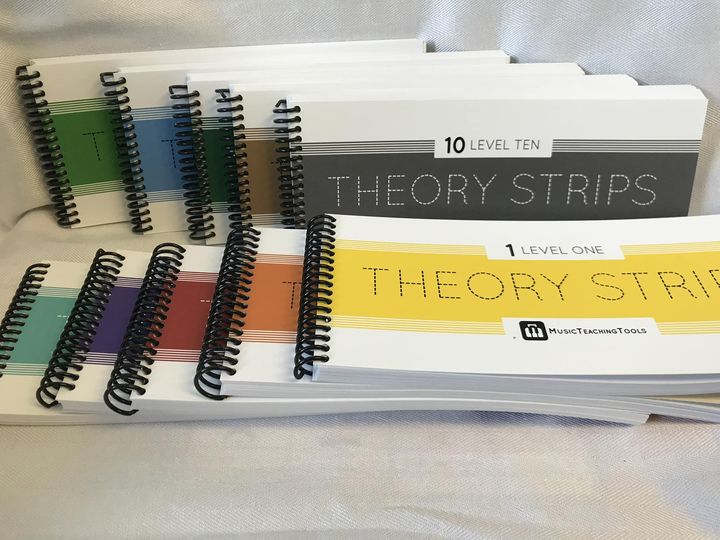
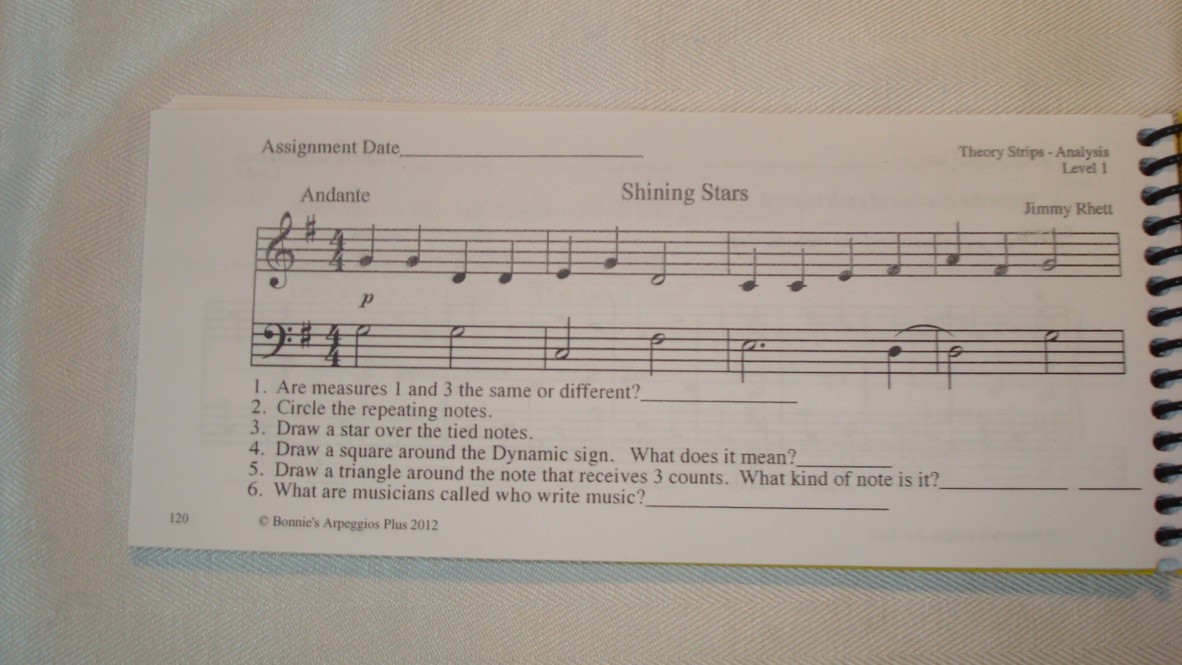
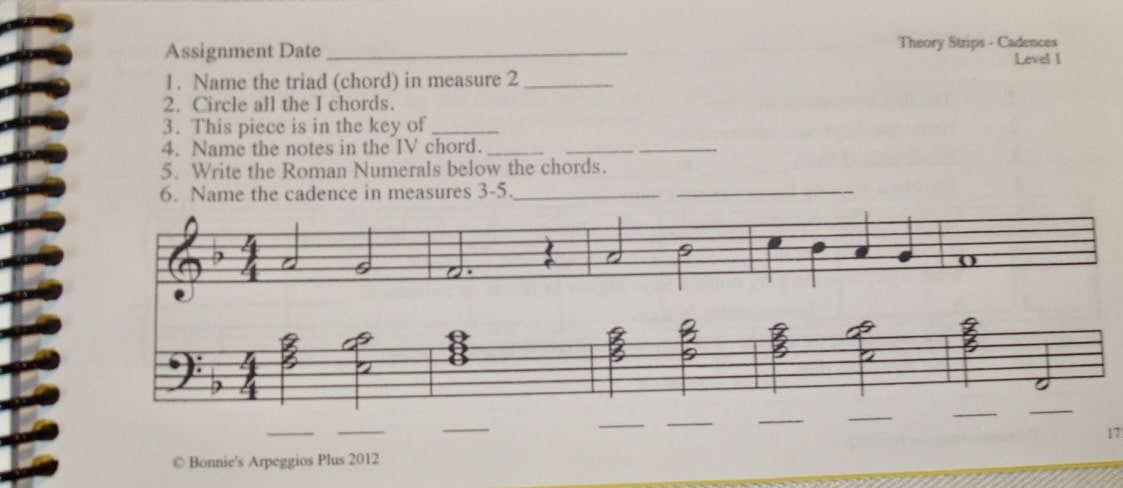
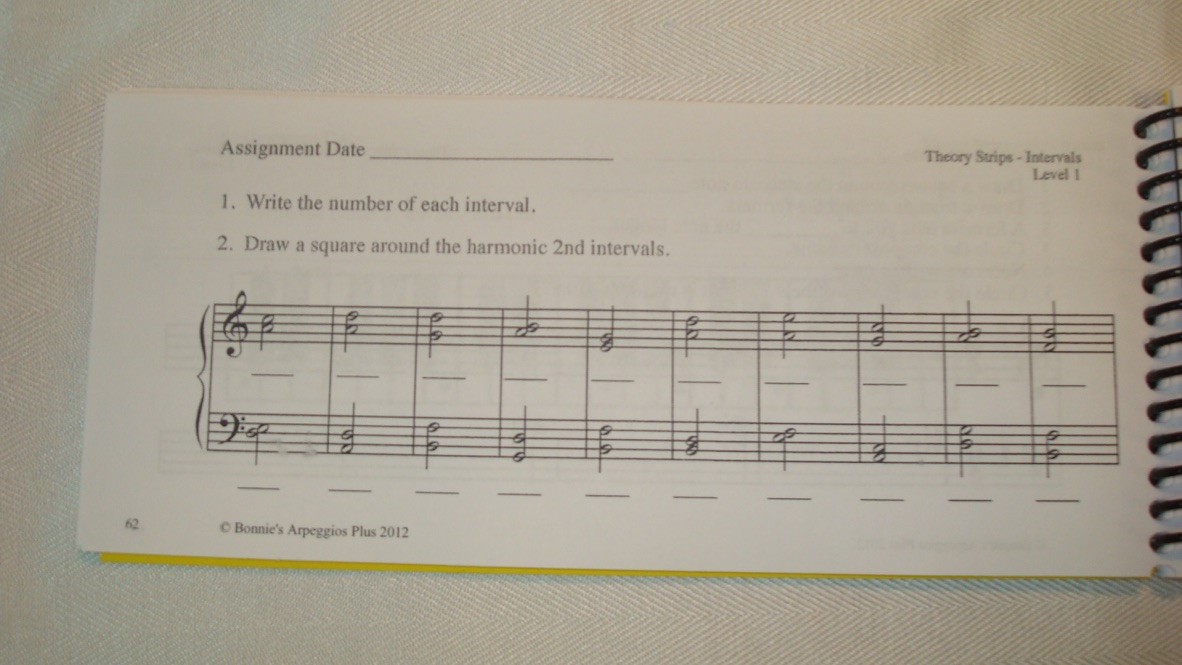
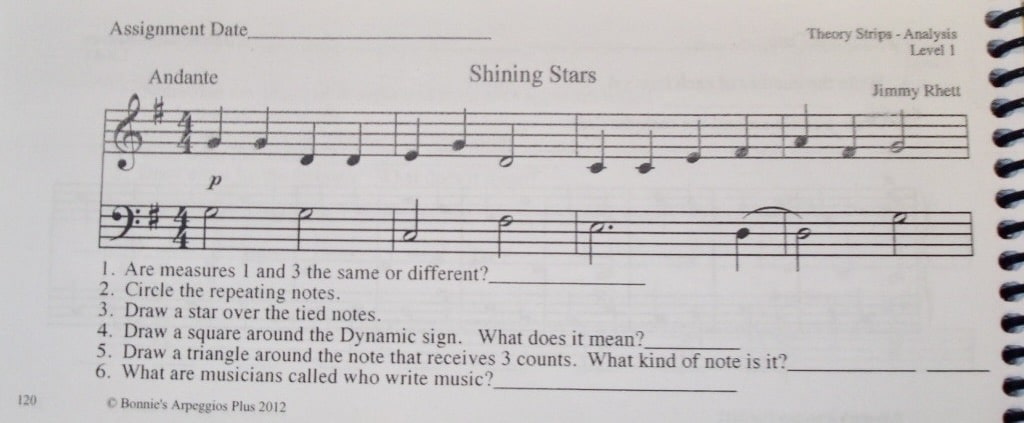
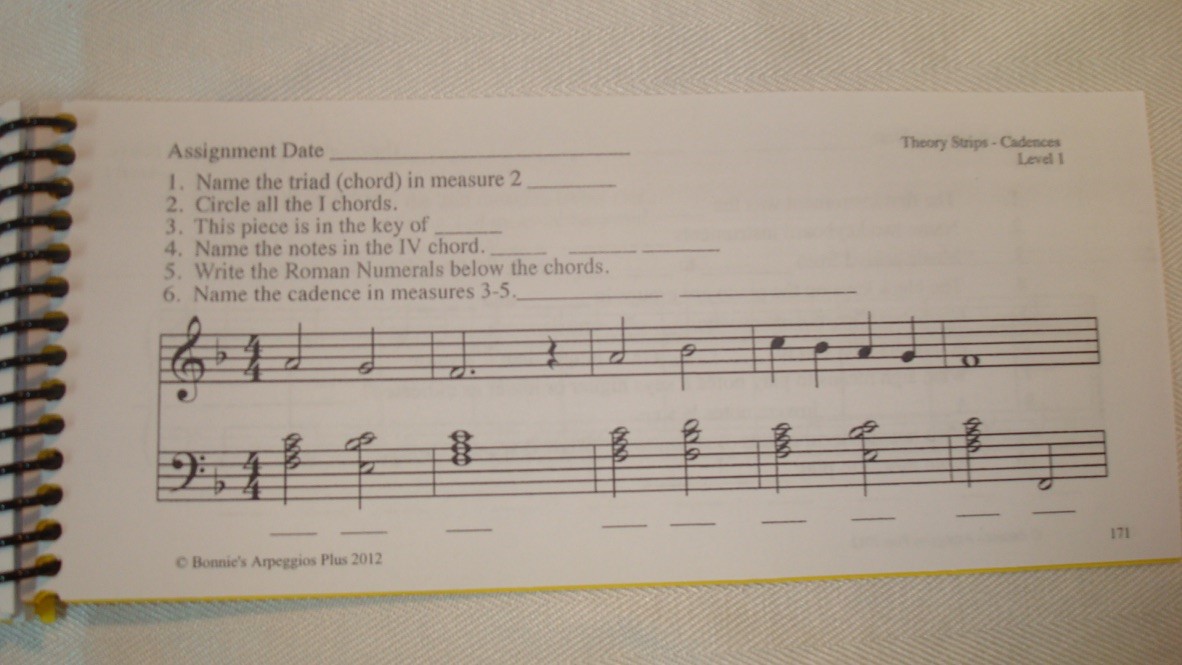
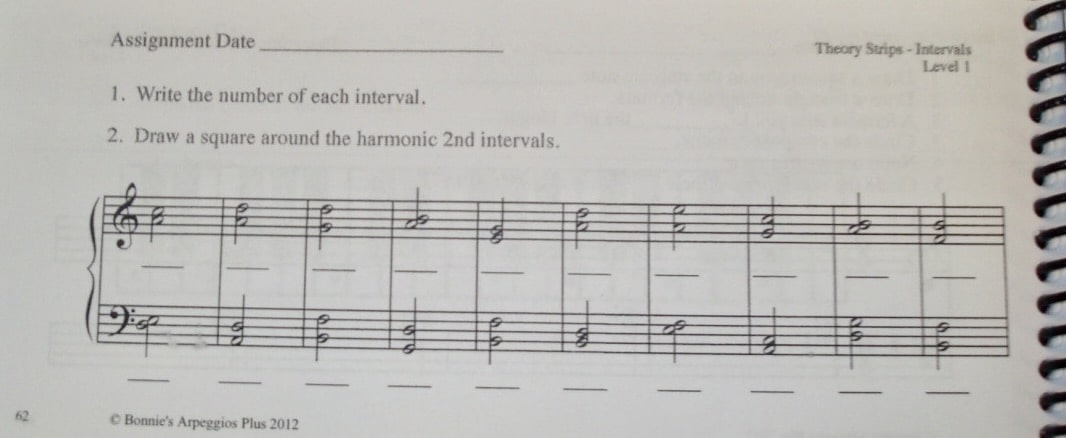


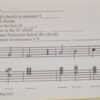
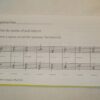
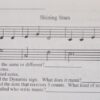
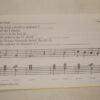
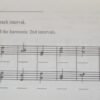

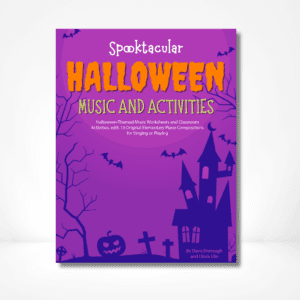


Reviews
There are no reviews yet.